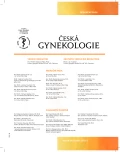Pilot study comparing tolerance of transperineal and endoanal ultrasound examination of anal sphincter
Authors:
Petr Hubka
; K. Švabík; J. Mašata; A. Martan
Authors‘ workplace:
Gynekologicko-porodnická klinika 1. LF UK a VFN, přednosta prof. MUDr. A. Martan, DrSc.
Published in:
Ceska Gynekol 2019; 84(2): 111-114
Category:
Overview
Objective: To compare diagnostic possibilities of endoanal (EAUS) and transperineal (TPUS) ultrasound during anal sphincter examination and patients’ preferences.
Design: Prospective study.
Setting: Department of Obstetrics and Gynaecology, 1st Faculty of Medicine, Charles University and General University Hospital, Prague.
Methods: Patients involved had EAUS and TPUS of anal sphincter.
First group were patients scheduled for control check after vaginal delivery complicated with anal sphincter injury (post OASI) and adequate suture.
Second (control) group contained new patients coming for urogynecological examination with some symptoms of anal incontinence.
Refusal were noted and after completing both ultrasounds patients marked on visual analog scale (VAS) the level of dyscomfort and answered few simple questions about their preference of exam in future.
Results: This study contains twenty-nine patients (fifteen post OASI and fourteen in control group). Two patients (post OASI) refused EAUS and one patient from control group did not mark the level of dyscomfort.
In post OASI group eleven patients (84.6%) considered EAUS as botherless or slighly bothering (VAS ≤ 3).
The average dyscomfort for EAUS was 1.92 and for TPUS 1.08. Five patients marked EAUS more dyscomfortable as TPUS and this difference is significant (p < 0.05).
In control group eleven patients (84.6%) marked EAUS as botherless or slightly bothering (VAS ≤ 3). There was no difference between post OASI and control group.
We have not found by any exam residual anal sphincter defect in any patient post OASI. For this reason we could not decide about efectivity.
In matter of future preference patients would prefer TPUS to EAUS in case of similar effectivity. However, in case of different effectivity patients would prefer the more effective.
Conclusion: Our patients prefer less dyscomfortable TPUS. The pilot study did not display higher effectivity of EAUS in diagnostics of residual anal sphincter defect.
Keywords:
anal incontinence – anal sphincter injury – ultrasound examination
Sources
1. Abdool, Z., Sultan, AH., Thakar, R. Ultrasound imaging of the anal sphincter complex: a review. Br J Radiol, 2012, 85, 1015, p. 865–875.
2. Andrews, V., Thakar, R., Sultan, AH. Outcome of obstetric anal sphincter injuries (OASIS) – role of structured management. Int Urogynecol J Pelvic Floor Dysfunct, 2009, 20, 8, p. 973–978.
3. Gagyor, D. Současné možnosti ultrazvukové diagnostiky v urogynekologii. Čes Gynek, 2016, 81, 4, s. 265–271.
4. RCOG [online]. Third - and Fourth-degree Perineal Tears, Management (Green-top Guideline No. 29). [cit. 12.7.2018]. Dostupné z https://www.rcog.org.uk/en/guidelines-research-services/guidelines/gtg29/
5. Roos, AM., Thakar, MR., Sultan, MA. Outcome of primary repair of obstetric anal sphincter injuries (OASIS) – does the grade of tear matter? Ultrasound Obstet Gynecol, 2010, 36(3), p. 368–374. doi: 10.1002/uog.7512
6. Ros, C., Martinez-Franco, E., Wozniak, MM., et al. Postpartum two - and three-dimensional ultrasound evaluation of anal sphincter complex in women with obstetric anal sphincter injury. Ultrasound Obstet Gynecol, 2017, 49, 4, p. 508–514.
7. Shek, KL., Guzman-Rojas, R., Dietz, HP. Residual defects of the external anal sphincter following primary repair: an observational study using transperineal ultrasound. Ultrasound Obstet Gynecol, 2014, 44, 6, p. 704–709.
8. Sultan, AH., Thakar, R. Lower genital tract and anal sphincter trauma. Best Pract Res Clin Obstet Gynaecol, 2002, 16, 1, p. 99–115.
9. Valsky, DV., Messing, B., Petkova, R., et al. Postpartum evaluation of the anal sphincter by transperineal three-dimensional ultrasound in primiparous women after vaginal delivery and following surgical repair of third-degree tears by the overlapping technique. Ultrasound Obstet Gynecol, 2007, 29, 2, p. 195–204.
10. Williams, AB., Bartram, CI., Halligan, S., et al. Anal sphincter damage after vaginal delivery using three-dimensional endosonography. Obstet Gynecol, 2001, 97, 5, Pt 1, p. 770–775.
11. Zahumensky, J., Kalis, V. Péče o ženy se závažným porodním poraněním hráze – doporučený postup. Ces Gynek, 2013, 78, suppl., s. 61.
Labels
Paediatric gynaecology Gynaecology and obstetrics Reproduction medicineArticle was published in
Czech Gynaecology

2019 Issue 2
Most read in this issue
- Uterine rupture during pregnancy and delivery: risk factors, symptoms and maternal and neonatal outcomes – restrospective cohort
- Sacrococcygeal teratoma
- Operative vaginal deliveries and their impact on maternal and neonatal outcomes – prospective analysis
- Latest findings on the placenta from the point of view of immunology, tolerance and mesenchymal stem cells
